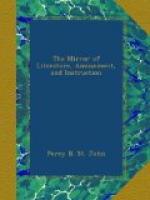Hooks.
Hal—I never use any hooks for salmon-fishing, except those which I am sure have been made by O’Shaughnessy, of Limerick; for even the hooks made in Dublin, though they seldom break, yet they now and then bend; and the English hooks made of cast steel in imitation of Irish ones are the worst of all. There is a fly nearly of the same colour as that which is destroyed; and I can tell you that I saw it made at Limerick by O’Shaughnessy himself, and tied on one of his own hooks. Should you catch with it a fish even of 30 lbs., I will answer for its strength and temper; it will neither break nor bend.—We should have such hooks in England, but the object of the fishing-tackle makers is to obtain them cheap, and most of their hooks are made to sell, and good hooks cannot be sold but at a good price.—The early Fellows of the Royal Society, who attended to all the useful and common arts, even improved fish-hooks; and Prince Rupert, an active member of that illustrious body, taught the art of tempering hooks to a person of the name of Kirby, under whose name, for more than a century, very good hooks were sold.
Variety in Trout.
Phys.—Tell us why they are so different from the river-trout, or why there should be two species or varieties in the same water.—Hal. Your question is a difficult one, and it has already been referred to in a former conversation; but I shall repeat what I stated before, that qualities occasioned by food, peculiarities of water, &c. are transmitted to the offspring, and produce varieties which retain their characters as long as they are exposed to the same circumstances, and only slowly lose them. Plenty of good food gives a silvery colour and round form to fish, and the offspring retain these characters. Feeding on shell-fish thickens the stomach, and in many generations, probably, the gillaroo trout becomes so distinct a variety, as to render it doubtful if it be not a distinct species. Even these smallest salmon trout have green backs, only black spots, and silvery bellies; from which it is evident that they are the offspring of lake trout, or lachs forelle, as it is called by the Germans; whilst the river trout, even when 4 or 5 lbs., as we see in one of these fish, though in excellent season, have red spots.
Char.
Phys. The char[1] is a most beautiful and excellent fish, and is, of course, a fish of prey. Is he not an object of sport to the angler?—Hal. They generally haunt deep, cool lakes, and are seldom found at the surface till late in the autumn. When they are at the surface they will, however, take either fly or minnow. I have known some caught in both these ways; and have myself taken a char, even in summer, in one of those beautiful, small, deep lakes in the Upper Tyrol, near Nazereit; but it was where a cool stream entered from the mountain; and the fish did not rise, but swallowed the artificial fly under water. I have fished for them in many lakes, without success, both in England and Scotland, and also amongst the Alps; and I am told the only sure way of taking them is by sinking a line with a bullet, and a hook having a live minnow attached to it, in the deep water which they usually haunt; and in this way, likewise, I have no doubt the umbla, or ombre chevalier, might be taken.




